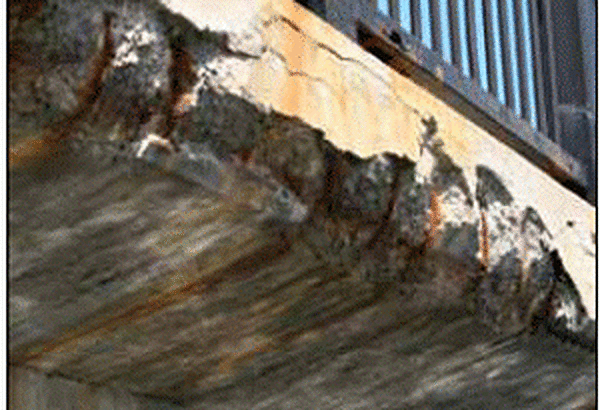Galvanized Rebar Prevents Spalling
How does galvanized rebar prevent spalling of concrete?

Reinforcing bar (rebar) is added to concrete to make it stronger; however, when rebar rusts, it can cause the concrete to fail or spall. This happens because the corrosion products of black steel are more voluminous than the metal the corrosion process consumes. As the corrosion products build up, increasing stress is placed on the surrounding concrete. Once these stresses are greater than the tensile strength of the concrete, it will break or spall.
Galvanizing protects rebar from rusting and thereby prevents the concrete from spalling. Zinc corrosion products have much less volume than that of black steel, and the corrosion products that do form migrate outward from the galvanized rebar. This prevents pressure from building up at the site of the junction between the concrete and the rebar.
In addition, galvanized steel has a much higher threshold for corrosion, meaning it takes more contaminants to cause corrosion of the galvanized coating. For example, it takes five times as much chlorides to initiate corrosion on galvanized rebar as it does on black steel.

When black rebar corrodes, corrosion products are produced that have a volume 5-10 times greater than that of the steel consumed in the corrosion reaction. When the steel rebar is embedded in concrete, the volume of these corrosion products caused outward pressure on the concrete, leading to spalling. Although concrete has outstanding compressive strength, it has a low tensile strength, which is the reason rebar is embedded within. Steel corrosion products can exert a tensile stress of 3-4 MPa on the concrete, which is enough to crack the concrete and cause spalling. Spalling not only created visual and structural integrity concerns, but it also allows additional corrosive substances, such as chlorides, to enter the cracks and further corrode the black rebar, exacerbating the structural problem.
One of the many benefits hot-dip galvanized rebar has over black rebar is spalling of the concrete is much less likely to occur because zinc corrosion products migrate into the concrete matrix rather than producing pressure at the bar concrete interface. This means a lower tensile stress is induced into the concrete. Zinc corrosion products also have less volume than steel corrosion products1. Migration of zinc corrosion products, such as zinc oxide and zinc hydroxide, also have the added benefit of filling voids and microcracks in the concrete, preventing penetration of corrosive substances such as chlorides1. Lower volume of corrosion products and migration of the zinc corrosion products away from the galvanized bar give hot-dip galvanized rebar a much longer service life in concrete and prevent spalling in high corrosion environment.
1: Yeomans, Stephen R., Galvanized Steel Reinforcement in Concrete, 2004
Learn more about galvanized rebar and earn continuing education credits by requesting an in-person seminar or taking our online rebar seminar.
© 2025 American Galvanizers Association. The material provided herein has been developed to provide accurate and authoritative information about after-fabrication hot-dip galvanized steel. This material provides general information only and is not intended as a substitute for competent professional examination and verification as to suitability and applicability. The information provided herein is not intended as a representation or warranty on the part of the AGA. Anyone making use of this information assumes all liability arising from such use.

